The SSD Diaries: Crucial's RealSSD C300
by Anand Lal Shimpi on July 13, 2010 12:39 AM ESTOverall System Performance using PCMark Vantage
Next up is PCMark Vantage, another system-wide performance suite. For those of you who aren’t familiar with PCMark Vantage, it ends up being the most real-world-like hard drive test I can come up with. It runs things like application launches, file searches, web browsing, contacts searching, video playback, photo editing and other completely mundane but real-world tasks. I’ve described the benchmark in great detail before but if you’d like to read up on what it does in particular, take a look at Futuremark’s whitepaper on the benchmark; it’s not perfect, but it’s good enough to be a member of a comprehensive storage benchmark suite. Any performance impacts here would most likely be reflected in the real world.
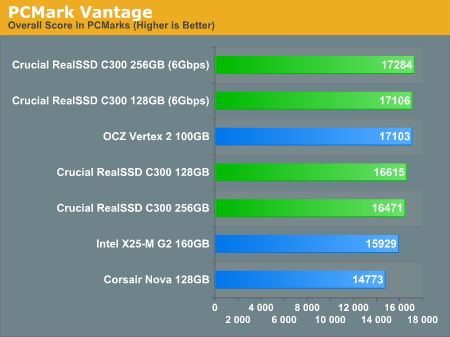
The overall PCMark vantage score puts the OCZ Vertex 2 ahead of the C300 by only 3%. Move to a 6Gbps controller and the C300 is now on par with the Vertex 2. Either way you look at it, general desktop performance should be about the same between the two for workloads exemplified by PCMark Vantage. The real world advantage over the Corsair Nova is 12.5%, just enough to be noticeable. This also reflects what I’ve seen in my own experiences with these drives as a user. There’s a noticeable performance increase between the X25-M/Indilinx class of SSDs and the new guard. It’s not earth shattering, and no where near the gap you see between SSDs and HDDs, but it’s noticeable on fast systems.
The memories suite includes a test involving importing pictures into Windows Photo Gallery and editing them, a fairly benign task that easily falls into the category of being very influenced by disk performance.
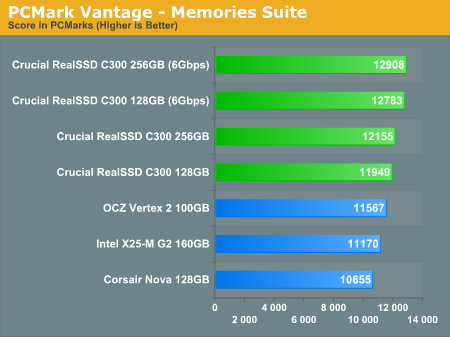
The TV and Movies tests focus on on video transcoding which is mostly CPU bound, but one of the tests involves Windows Media Center which tends to be disk bound.
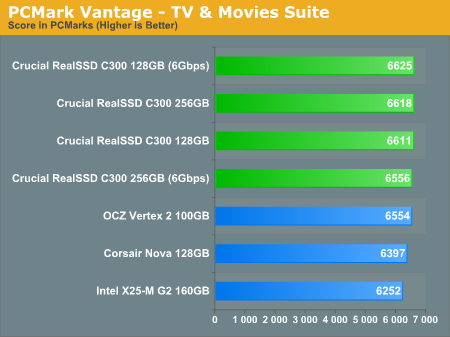
The gaming tests are very well suited to SSDs since they spend a good portion of their time focusing on reading textures and loading level data. All of the SSDs dominate here, but as you'll see later on in my gaming tests the benefits of an SSD really vary depending on the game. Take these results as a best case scenario of what can happen, not the norm.
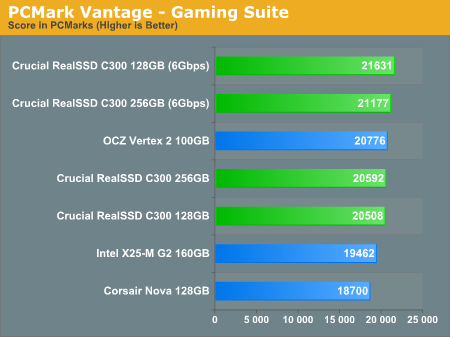
In the Music suite the main test is a multitasking scenario: the test simulates surfing the web in IE7, transcoding an audio file and adding music to Windows Media Player (the most disk intensive portion of the test).
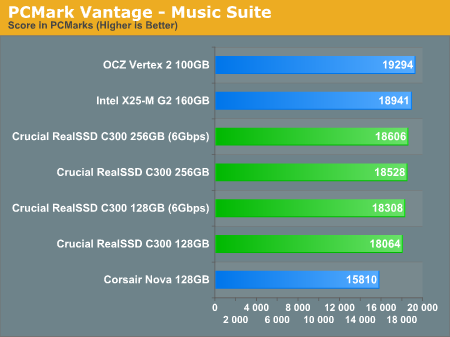
The Communications suite is made up of two tests, both involving light multitasking. The first test simulates data encryption/decryption while running message rules in Windows Mail. The second test simulates web surfing (including opening/closing tabs) in IE7, data decryption and running Windows Defender.
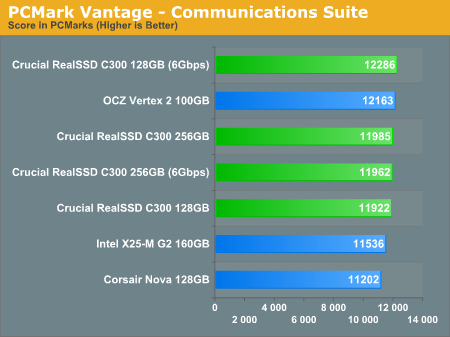
I love PCMark's Productivity test; in this test there are four tasks going on at once, searching through Windows contacts, searching through Windows Mail, browsing multiple webpages in IE7 and loading applications. This is as real world of a scenario as you get and it happens to be representative of one of the most frustrating HDD usage models - trying to do multiple things at once. There's nothing more annoying than trying to launch a simple application while you're doing other things in the background and have the load take forever.

The final PCMark Vantage suite is HDD specific and this is where you'll see the biggest differences between the drives:
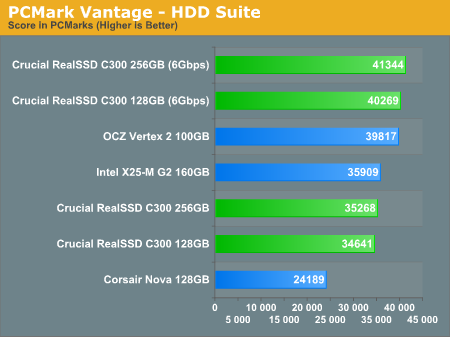
In the HDD suite itself, OCZ holds the clear advantage with the Vertex 2 showing up 15% faster than the 128GB RealSSD C300. Moving to a 6Gbps interface basically levels the playing field between the two.










51 Comments
View All Comments
strikeback03 - Tuesday, July 13, 2010 - link
Really? I have 3 computers, and can see a use for the 30-40GB, 60-80GB, and 100+GB size drives depending on which system I am thinking of. For my HTPC, a small drive would be fine, all it holds is the OS. For my desktop, I have an 80GB X25G2, as IMO a smaller drive would be iffy when 2 operating systems are installed on the drive, and allowing for extra spare area. For my laptop I wouldn't consider anything under 100GB, as I don't want to have to carry a separate external drive to store stuff to.erple2 - Tuesday, July 13, 2010 - link
I'll second that - my laptop has the 160 gig Intel G2 drive in it because I have installed slightly more than the OS on it (a few steam games + WoW = need more than 80 gig).I don't need more than about 120-160 gigs on my laptop (that's what my home server is for). My desktop would be in the same boat - I'd need enough "space" to install some large applications on it plus the OS.
I've heard people recommend that you should install applications on spindle drives, but the reality is that some of those applications are very slow loading on a spindle drive.
Personally, I don't care if my OS takes 5 minutes to boot. I almost never shut down anyway.
neoflux - Tuesday, July 13, 2010 - link
Fantastic article as always, Anand. Informative, investigative, and conclusive. I couldn't ask for anything else ( other than the funds to purchase a Vertex 2 :P ).Slaimus - Tuesday, July 13, 2010 - link
With such a large DRAM cache, is there greater risk of data corruption when there is a power outage or power supply failure?Anand Lal Shimpi - Tuesday, July 13, 2010 - link
Crucial claims to store very little user data in the external DRAM, it's mostly to give the firmware room to store mapping tables and history data to make better decisions about how to organize future writes.Take care,
Anand
GourdFreeMan - Tuesday, July 13, 2010 - link
Have you ever actually put this to the test, though?Intel claims they do the exact same thing with their DRAM, yet I have had applications that were not in use become corrupt after a sudden power loss (i.e. bluescreen after resuming from hibernation, cat depressing laptop power button) on my Intel G2 drives. The mechanical drives that were in the exact same system prior to being replaced by SSDs only lost minimal amounts of data (and typically only the data in use at the time) under the exact same power loss scenarios.
Echo147 - Tuesday, July 13, 2010 - link
My first SSD - And it couldn't be picked up after just 5 hours. Pretty crushed :sIt'd been shipped with Firmware 0001 which I'm guessing was a large oversight by Crucial or the retailer. I wasn't about to go flashing a £500 drive, so it's in RMA as we speak.
Will be waiting for Intel's 25nm offerings before dipping my burned toes again...
greggm2000 - Tuesday, July 13, 2010 - link
Anand,Are there any plans to test these drives in RAID configuration? You've already done so with Intel's cheapest value drive, but for those of us who are considering in the higher end drives, it would be interesting to know such things as will a pair of Crucial RealSSD 128GB drives on SATA outperform a single 256GB on SATA 6Gb... or even how well 4 of the 64GB drives compare as well. Also, how do the Sandforce drives compare in RAID to the others.
Thanks! Great article as always!
mckirkus - Tuesday, July 13, 2010 - link
Just to get a sense of what is used by most humans (hard drives, not VRaptors).Alkapwn - Tuesday, July 13, 2010 - link
Do SandForce controllers suffer when BitLocker is enabled? I'm guessing there would be less predictable data patterns for it's controller to use, and thus might be slower? Would that then solidly put the lead in Crucials favor?